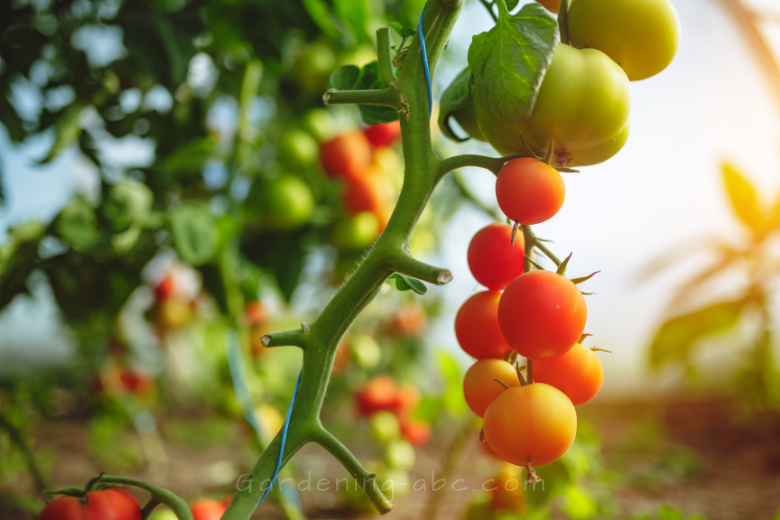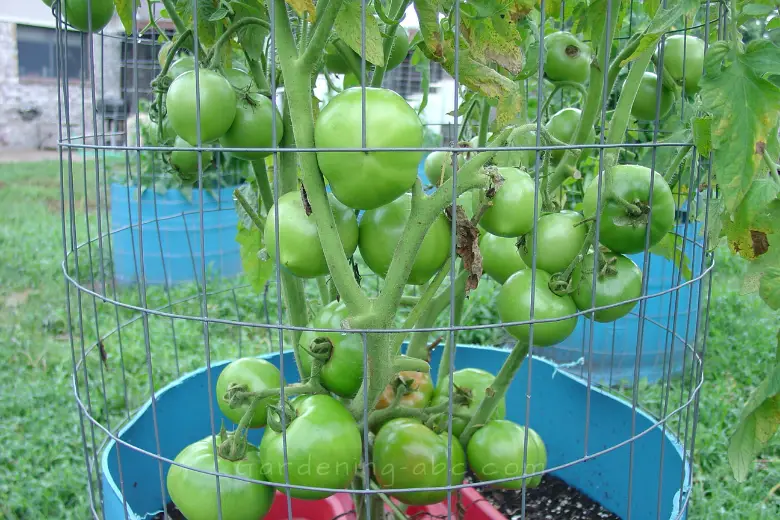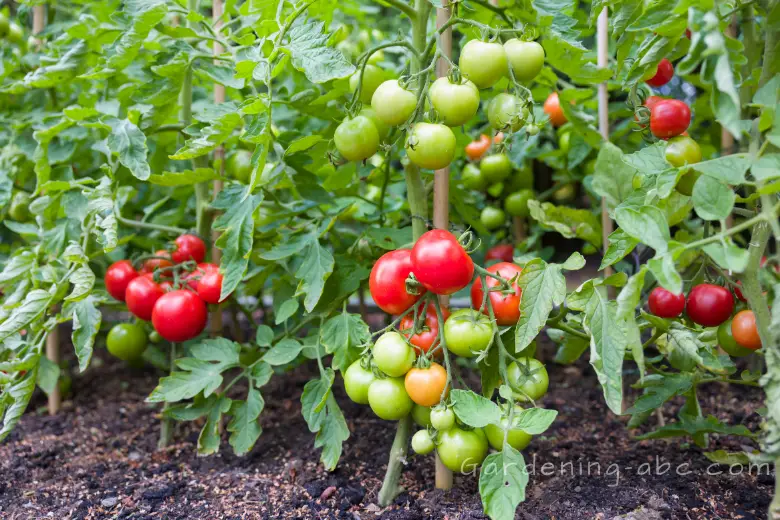We use affiliate links to run our site. When you buy through links on our site, we may earn an affiliate commission, without any added cost to you. Learn more
When it comes to growing tomatoes, one of the key considerations for gardeners and farmers is the type of tomato plant they choose to cultivate.
Two main categories dominate the tomato-growing world: determinate and indeterminate tomatoes. Each variety has its own unique characteristics and growth patterns, making it essential to understand the differences between them.
In this article, we will delve into the distinctive features of determinate and indeterminate tomatoes, allowing you to make informed decisions for your tomato-growing endeavors.
Determinate Tomatoes
Determinate tomatoes, also known as bush tomatoes, are a specific type of tomato plant that tends to have a compact, bush-like growth habit.
These plants typically reach a predetermined height and stop growing once they have produced a set number of fruit clusters.
The growth cycle of determinate tomatoes is relatively short, usually spanning around two to three months.
Growth Habit and Structure
Determinate tomato plants are characterized by their bushy appearance and relatively limited vertical growth.
They tend to grow to a fixed height, usually ranging between two to four feet. This compact growth habit makes them ideal for small gardens or containers where space may be a limitation.
Fruit Production
One of the key features of determinate tomatoes is their synchronous fruit ripening. The fruit clusters on determinate plants tend to mature around the same time, providing a concentrated harvest period.
This characteristic is particularly advantageous for those looking to harvest a large crop for canning or preserving purposes.
Pruning and Support
Since determinate tomatoes have a predetermined height, they generally require less pruning and support compared to their indeterminate counterparts.
However, removing suckers (small shoots that develop in the leaf axils) is still recommended to redirect the plant’s energy towards fruit production.
Indeterminate Tomatoes
In contrast to determinate tomatoes, indeterminate tomatoes are known for their vining growth habit and continuous production of fruit throughout the growing season.
These plants have an indeterminate growth pattern, meaning they keep growing and producing fruit until unfavorable conditions or diseases affect them.
Growth Habit and Structure
Indeterminate tomato plants are characterized by their vigorous growth and continuous upward vine expansion. They tend to grow taller, often reaching heights of six feet or more.
Due to their vertical growth habit, indeterminate tomatoes are best suited for gardens with ample space or for those utilizing trellises and stakes to support the vines.
Fruit Production
Unlike determinate tomatoes, indeterminate varieties produce fruit over an extended period. As the plants continue to grow and develop new branches, they also produce new fruit clusters.
This results in a more staggered and prolonged harvest season, allowing for a steady supply of fresh tomatoes throughout the summer and even into the fall.
Pruning and Support
Indeterminate tomato plants require regular pruning and support to manage their vigorous growth.
Pruning involves removing suckers and excess foliage to improve air circulation, reduce the risk of diseases, and direct the plant’s energy towards fruit production.
Staking or trellising is essential to support the weight of the vines and ensure they grow vertically, optimizing space utilization.
How to Choose the Right Tomato Type for Your Needs

Now that we have explored the characteristics of determinate and indeterminate tomatoes, it’s time to consider which type is best suited for your specific requirements.
To assist in your decision-making process, let’s delve into some factors to consider when choosing between these two tomato varieties.
1. Space Availability
If you have limited space, such as a small backyard or a container garden, determinate tomatoes are an excellent choice.
Their compact growth habit allows for efficient space utilization, and their concentrated harvest period is advantageous for preserving purposes.
On the other hand, if you have ample space or a larger garden, indeterminate tomatoes offer several benefits. Their vigorous growth and continuous fruit production provide a steady supply of fresh tomatoes throughout the season, making them ideal for regular consumption or sharing with friends and neighbors.
2. Harvest Preferences
Consider your harvest preferences when choosing between determinate and indeterminate tomatoes.
If you prefer a large quantity of ripe tomatoes all at once for canning or making sauces, determinate varieties are the way to go. Their synchronous fruit ripening ensures a bountiful harvest within a relatively short period.
However, if you enjoy a more extended harvest season, with a continuous supply of tomatoes over several months, indeterminate varieties are the better option.
Their staggered fruit production allows for a more prolonged and diverse harvest, catering to different culinary needs and preferences.
3. Gardening Effort
The level of gardening effort you are willing to invest is another crucial factor to consider.
Determinate tomatoes generally require less maintenance and pruning due to their compact size and predetermined growth habit.
If you have limited time or prefer a low-maintenance approach, determinate varieties are more suitable.
Indeterminate tomatoes, on the other hand, demand more attention and effort in terms of pruning, support, and overall management.
Regular pruning of suckers and providing adequate support for the growing vines is necessary to ensure optimal growth, fruit production, and disease prevention.
If you enjoy the process of tending to your plants and are willing to invest time and effort, indeterminate tomatoes can be a rewarding choice.
4. Disease Resistance
Disease resistance is an essential consideration when selecting tomato varieties, as certain diseases can significantly impact plant health and fruit production.
Determinate tomatoes are known for their relatively higher resistance to diseases such as early blight and leaf spots. Their compact growth and shorter growing period make them less susceptible to infections.
Indeterminate tomatoes, while generally more susceptible to diseases due to their extended growth period, offer a wider selection of disease-resistant varieties.
By choosing disease-resistant indeterminate cultivars, you can mitigate the risks and enjoy the benefits of continuous fruit production.
9 Deadly Tomato Pests That Can Ruin Your Tomato Yield
Some Best Recommended Varieties:
Some of the recommended Determinate and Indeterminate Tomato Varieties include:

Determinate Varieties:
- San Marzano Nano: Unlike other San Marzano tomatoes, this determinate variety stays at a manageable size. It is a juicy, flavorful Roma-style heirloom plum tomato, ideal for cooking and canning.
- Rutgers: This determinate variety produces a large early crop of fruit followed by several more throughout the season. The plants are disease-resistant, and the fruits have excellent flavor and can withstand handling.
- Celebrity: This determinate hybrid globe tomato produces fruit weighing 8 to 10 ounces within approximately 70 days of planting.
- Marglobe: A determinate heirloom with a somewhat spreading growth habit, it ripens at around 75 days. Marglobe has disease resistance and firm flesh that resists bruising and cracking.
- Amish Paste: This medium-sized pear tomato is a sweet-tasting heirloom that grows to between 8-12 ounces. It is excellent for cooking, canning, and slicing into salads.
Indeterminate Varieties:
- Big Boy: An indeterminate hybrid tomato, Big Boy produces fruit weighing 10 to 16 ounces in about 78 days after planting.
- Big Beef: This indeterminate hybrid beefsteak tomato yields fruit weighing 10 to 12 ounces within approximately 73 days from planting. It was a 1994 All-America Selections Winner.
- Juliet: This indeterminate hybrid elongated cherry tomato produces 1-ounce fruit approximately 60 days after planting. It was a 1999 All-America Selections Winner.
- Early Girl: An indeterminate hybrid globe tomato, Early Girl produces fruit weighing about 8 ounces in around 50 to 52 days after planting.
- Better Boy: An indeterminate hybrid beefsteak tomato, Better Boy produces fruit weighing 10 to 16 ounces in about 75 days from planting.
- Sun Sugar: An indeterminate hybrid cherry tomato with orange fruit, Sun Sugar produces 1-ounce fruit in about 62 days after planting.
These varieties offer a range of flavors, sizes, and growth habits, allowing you to choose the best options based on your preferences and growing conditions. Happy gardening and enjoy the abundance of delicious tomatoes!
Conclusion:
Understanding the difference between determinate and indeterminate tomatoes is essential for successful gardening and enjoying a bountiful harvest. By learning about their growth habits and characteristics, you can make informed choices when selecting tomato varieties for your garden.
We encourage you to share this post with fellow gardening enthusiasts and anyone interested in growing their own tomatoes. Sharing knowledge is a wonderful way to inspire and help others on their gardening journey.
If you found this article helpful, we invite you to explore more informative articles on our website. We cover a wide range of topics related to gardening, plants, and flowers, providing valuable insights and tips to enhance your gardening experience.
Amazon and the Amazon logo are trademarks of Amazon.com, Inc, or its affiliates.

Hi there! My name is Prasenjit and I’m an avid gardener and someone who has grown a passion for growing plants. From my hands-on experience, I have learned what works and what doesn’t. Here I share everything I have learned.
